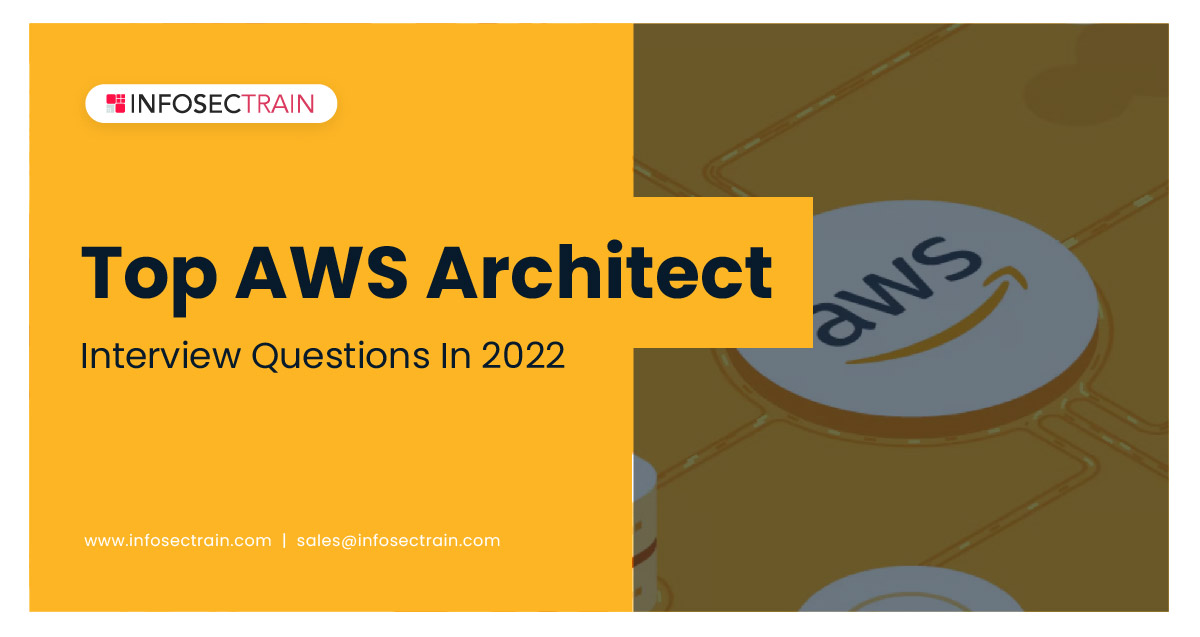Top AWS Architect Interview Questions In 2022

Amazon Web Services (AWS) is a well-known and revolutionized cloud platform providing the leading cloud services for multiple enterprises. Many organizations are actively recruiting cloud professionals, and AWS professionals are the top-notch demanding career in recent times. In this comprehensive blog, we have curated a list of Top AWS Architect Interview Questions.
1.What is the AWS Serverless Application Model?
The AWS Serverless Application Model (AWS SAM) is an open-source framework used to build serverless applications and provides easy syntax to define the functions, databases, APIs, and event source mappings. It includes two components:
- AWS SAM template specification
- AWS SAM command-line interface
2. List out some of the commands used in AWS SAM CLI.
The following is the list of commands used in AWS SAM CLI:
- sam build
- sam deploy
- sam logs
- sam delete
- sam init
- sam package
- sam local invoke
- sam local start-api
- sam local start-lambda
- sam local generate-event
3. What is Amazon S3?
Amazon Simple Storage Service (Amazon S3) is the object storage web service offered by Amazon. Amazon S3 is a storage platform that provides data availability, security, scalability, and performance. Amazon S3 stores and secures data and provides various features to organize, optimize, and configure the data to meet business requirements.
4. What is Amazon EC2?
Amazon Elastic Compute Cloud (Amazon EC2) is a web service interface offered by Amazon that provides scalable computing capacity in the cloud. It helps control computing resources and runs on the computing environment. It reduces the time required to boot new server instances and allows the application to scale quickly based on the requirements.
5. What is AWS’s Well-Architected framework?
AWS’s Well-Architected framework allows architects to build secure, resilient, efficient, and highly performing infrastructure for various workloads and applications. This framework consists of six pillars:
- Operational Excellence
- Performance Efficiency
- Security
- Cost Optimization
- Reliability
- Sustainability
6. What is Service Limit in AWS?
Service Limit is an AWS service that proactively monitors and manages the Service quotas for each account. It helps to protect from accidental provisioning of resources more than needed. AWS allows increasing the service limit by creating a case in the AWS Support Console.
7. What are the various types of AWS EC2 Instances?
The following are the various types of AWS EC2 instances:
- General Purpose Instance
- Compute Optimized Instance
- Memory Optimized Instance
- Storage Optimized Instance
- Accelerated Computing Instance
8. Explain VPC.
Amazon Virtual Private Cloud (Amazon VPC) is a virtual network that allows users to connect with the cloud environment, including IP addresses, subnets, route tables, and network gateways. It helps to customize the network configuration seamlessly. The VPC allows multiple layers of security to control access to EC2 instances in each subnet.
9. What are the components of VPC?
The following are the components of Amazon VPC:
- A Virtual Private Cloud
- Subnet
- NAT Gateway
- VPC Endpoints
- Egress-only Internet Gateway
- Peering Connection
- Internet Gateway
- Virtual Private Gateway
10. Why is the subnet used in AWS?
A Subnet is a group of IP addresses that connect with AWS resources, such as EC2 instances and DB instances. It helps to divide the complex network into small subnetworks and helps to reduce data loss and errors.
11. What are Route Tables?
Route Tables is a set of rules to determine the network traffic from the subnets. Each subnet is associated with a route table to maintain communication with the network, and multiple subnets are also associated with a single route table.
12. What are the common issues occurring while connecting with EC2 instances?
The following are the common connection issues that occurred while connecting with EC2 instances:
- Error: User key not recognized by the server
- Error: Unable to load key
- Error: Unprotected private key file
- Error: Host key validation failed for EC2 Instance Connect
- Error: Server unexpectedly closed network connection
- Error: Connecting to your instance: Connection timed out
- Error: Server refused our key or No supported authentication methods available
- Cannot ping instance
- Can’t connect to Ubuntu instance using EC2 Instance Connect
13. What is Amazon Route 53?
Amazon Route 53 is the Domain Name System (DNS) web service, which is highly scalable and available. It connects user requests to internet applications by translating human-readable URLs into computer-understandable IP addresses. For example, translating www.infosectrain.com into 103.20.214.236. Also, this service helps us to register domain names and provide specific routing policies to manage the DNS traffic as well as providing DNS health checks.
14. What is Amazon ElastiCache?
AmazonElastiCache is a fully managed, in-memory caching service that supports real-time use cases. It is highly scalable and accelerates application’s performance by adding a cache layer between your application and DB services like RDS etc. ElastiCache supports two engines, which are as follows:
- ElastiCache Memcached
- ElastiCache Redis
15. What is Amazon SNS?
Amazon Simple Notification Service (Amazon SNS) is a managed push notification service that sends notifications to subscribers. The SNS service is highly flexible, cost-effective, and easy to use and manage messaging architecture.
16. What is the difference between SNS and SQS?
The primary difference between SNS and SQS is that the Simple Notification Service (SNS) is a fully managed push notification service that sends bulk messages to many subscribers. In contrast, a Simple Queue System (SQS) is a fully managed message queuing service that sends messages only when receivers poll SQS for messages.
17. What are the security groups in AWS?
Security groups are virtual firewalls that control the incoming and outgoing network traffic in EC2 instances. It ensures that the traffic flowing through the instances is restricted with security rules and protocols.
18. What is the AWS Auto Scaling Lifecycle Hook?
Amazon EC2 Auto Scaling allows adding lifecycle hooks to auto-scaling groups. Each autoscaling group includes multiple lifecycle hooks, which help to derive the solutions and perform custom actions on instances when a lifecycle event occurs.
19. What is AWS Lambda?
AWS Lambda is an event-driven serverless computing service that runs the code without managing or provisioning servers. It automatically scales the application by executing the code in response to each event by precisely scaling the workload’s size.
20. What are the best practices for securing Amazon EC2 instances?
The following are the best practices for securing AWS EC2 instances:
- Use of IAM roles wherever possible instead of sharing credentials
- Configure security groups to restrict network traffic
- Use Amazon EBS encryption
- Use AWS Config to monitor changes in the AWS resources
- Use Amazon Inspector to identify vulnerabilities in the EC2 instance
- Use Amazon CloudWatch and AWS CloudTrail to monitor activity
AWS Architect with InfosecTrain
AWS offers several career opportunities for cloud professionals skilled in working on AWS services, such as AWS EC2, Amazon S3, Amazon RDS, Amazon CloudFront, etc.
InfosecTrain is one of the best training and consultancy services for a wide range of cybersecurity and information security domains. It offers an instructor-led training program on AWS Solutions Architect that helps you to achieve a complete understanding of how to deploy applications on the AWS cloud.







 1800-843-7890 (India)
1800-843-7890 (India)